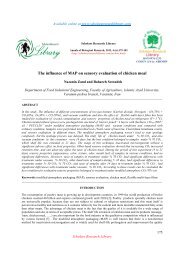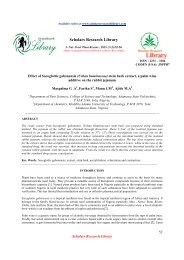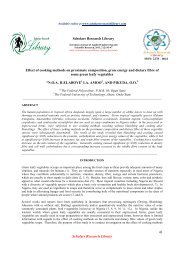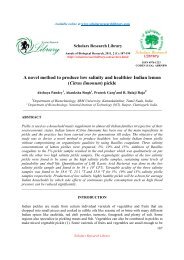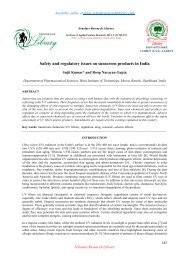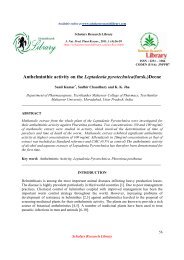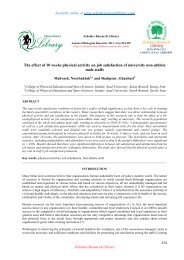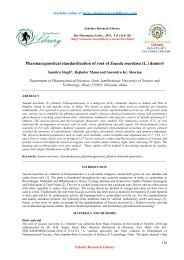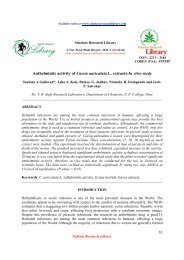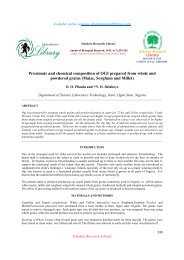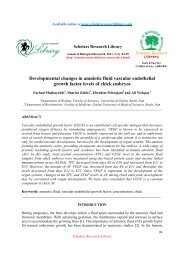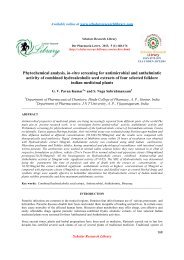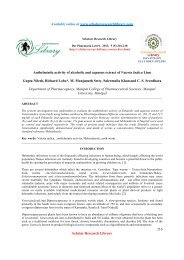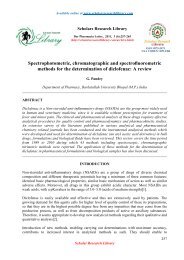Development of modified transdermal spray formulation of psoralen ...
Development of modified transdermal spray formulation of psoralen ...
Development of modified transdermal spray formulation of psoralen ...
You also want an ePaper? Increase the reach of your titles
YUMPU automatically turns print PDFs into web optimized ePapers that Google loves.
Available online at www.scholarsresearchlibrary.com<br />
Scholars Research Library<br />
Der Pharmacia Lettre, 2013, 5 (2):85-94<br />
(http://scholarsresearchlibrary.com/archive.html)<br />
ISSN 0975-5071<br />
USA CODEN: DPLEB4<br />
<strong>Development</strong> <strong>of</strong> <strong>modified</strong> <strong>transdermal</strong> <strong>spray</strong> <strong>formulation</strong> <strong>of</strong> <strong>psoralen</strong> extract<br />
Kaur Sukhbir, Kaur Navneet, Sharma A. K. and Kanwar Kapil<br />
CT Institute <strong>of</strong> Pharmaceutical Sciences, Jalandhar, Punjab, India<br />
_____________________________________________________________________________________________<br />
ABSTRACT<br />
The present investigation was undertaken to fabricate <strong>modified</strong> transport <strong>psoralen</strong> <strong>transdermal</strong> <strong>spray</strong> using ethyl<br />
cellulose as film-forming polymer and to carry out in vitro characterization <strong>of</strong> an optimized <strong>formulation</strong>.<br />
Formulated Topical <strong>spray</strong> was evaluated by pH, clarity <strong>of</strong> solution, <strong>spray</strong> pattern, area covered by each <strong>spray</strong>,<br />
dermal adhesion <strong>of</strong> film, flexibility <strong>of</strong> film, water washability <strong>of</strong> film, leakage from container, average weight <strong>of</strong><br />
<strong>formulation</strong> per metered dose (or per <strong>spray</strong>), drug content per <strong>spray</strong>, film formation time, in vitro drug transport,<br />
drug content uniformity after 10 th <strong>spray</strong>, 15 th <strong>spray</strong>, 30 th <strong>spray</strong>, 40 th <strong>spray</strong> and viscosity. Batch F1 containing ethyl<br />
cellulose (4%) and polyethylene glycol (0.25%) was found to give good clarity <strong>of</strong> solution, evaporation rate, <strong>spray</strong><br />
pattern, and tackiness <strong>of</strong> the film. Diffusion studies <strong>of</strong> the optimized <strong>formulation</strong> through the semipermeable<br />
membrane showed the release <strong>of</strong> drug to the extent 50% over a period <strong>of</strong> 6 hours. Stability studies were conducted<br />
as per ICH guidelines and indicated that <strong>formulation</strong> was stable. Skin irritation studies were performed using rat as<br />
an animal model. The results obtained show that the <strong>transdermal</strong> <strong>spray</strong> can be a promising and innovative<br />
therapeutic system for the <strong>transdermal</strong> administration <strong>of</strong> <strong>psoralen</strong>.<br />
Keywords: <strong>psoralen</strong>, psoralea corylifolia seeds, <strong>transdermal</strong> <strong>spray</strong>, ethyl cellulose, factorial design.<br />
_____________________________________________________________________________________________<br />
INTRODUCTION<br />
Leucoderma is the most common chronic depigmentation disorder or hypopigmentation (1). It includes the loss <strong>of</strong><br />
functioning melanocytes which causes the appearance <strong>of</strong> white patches on the skin (2). The most common treatment<br />
in leucoderma is the use <strong>of</strong> topical or oral <strong>psoralen</strong>s followed by exposure to UVA radiation in the region <strong>of</strong> 280-<br />
315 nm wavelengths (3). A thin coat <strong>of</strong> 0.01% to 0.1% methoxsalen ointment is applied to leucoderma skin. After<br />
30 min, the skin is exposed to 0.12J/cm 2 to 0.25 J/cm 2 UVA with increments <strong>of</strong> 0.12J/cm 2 weekly (4). Psoralen is<br />
an isomer <strong>of</strong> furanocoumarin obtained from the fruits <strong>of</strong> Psoralea corylifolia Linn. (Family-Leguminosae). It<br />
is a photosensitizing agent. Psoralea corylifolia (Bakuchi) contains furanocourmarins like <strong>psoralen</strong> (5). Psoralen<br />
stimulates skin to produce melanin pigment when exposed to sunlight. The seeds <strong>of</strong> psoralea corylifolia are<br />
believed to facilitate amino acid transport across the intestinal mucosa by acting as a photo-sensitizer for the<br />
initiation <strong>of</strong> erythema on the spots <strong>of</strong> leucoderma. Furanocourmarins initate the transformation <strong>of</strong> DOPA to melanin<br />
under the influence <strong>of</strong> UV Light or sunlight. Epidermal tissues contains free sulphydryl groups (6). These sulphydryl<br />
group bind the free copper ions which are required for the function <strong>of</strong> tyrosinase (7). Psoralea corylifolia (Bakuchi)<br />
helps in the release <strong>of</strong> SH-group bound copper as free copper, which activates the tyrosinase activity for melanin<br />
synthesis (URL. 1).<br />
As per the literature survey the topical treatment containing <strong>psoralen</strong> (Psoralea corylifolia seeds) for leucoderma are<br />
mainly creams, ointments and oil (URL. 1, URL. 2, URL. 3, URL. 4). Therefore the objective <strong>of</strong> the study was to<br />
Scholar Research Library<br />
85
Kaur Sukhbir et al Der Pharmacia Lettre, 2013, 5 (2):85-94<br />
______________________________________________________________________________<br />
develop an optimized <strong>formulation</strong> in the form <strong>of</strong> a topical <strong>spray</strong> containing <strong>psoralen</strong> (Psoralea corylifolia seed) for<br />
the treatment <strong>of</strong> leucoderma. The aim <strong>of</strong> the present research work was to develop patient-friendly <strong>modified</strong><br />
transport <strong>transdermal</strong> <strong>spray</strong> <strong>of</strong> <strong>psoralen</strong> using ethyl cellulose as film-forming polymer. A 3 2 full factorial design was<br />
employed for optimization. Developed Topical <strong>spray</strong> was evaluated for pH, clarity <strong>of</strong> solution, <strong>spray</strong> pattern, area<br />
covered by each <strong>spray</strong>, dermal adhesion <strong>of</strong> film, flexibility <strong>of</strong> film, water washability <strong>of</strong> film, leakage from<br />
container, average weight <strong>of</strong> <strong>formulation</strong> per per <strong>spray</strong>, drug content per <strong>spray</strong>, film formation time, in vitro drug<br />
transport, drug content uniformity after 10 th <strong>spray</strong>, 15 th <strong>spray</strong>, 30 th <strong>spray</strong>, 40 th <strong>spray</strong> and viscosity.<br />
MATERIALS AND METHODS<br />
Materials:<br />
Psoralea corylifolia seeds was kindly obtained as a Gift sample from Aimil pharmaceuticals Pvt. Ltd Delhi, India.<br />
Psoralen marker was purchased from Kumaon Chemicals Pvt .Ltd Uttrakhand, India. α-naphthol was procured from<br />
S.D. fine chemicals Pvt. Ltd Mumbai, India. Sodium hydroxide, Concentrated Hydrochloric Acid, Fehling’s A<br />
solution, Fehling’s B solution were obtained from Nice chemicals Pvt. Ltd Kochi, India. Sodium carbonate was<br />
obtained from Loba chemicals Pvt. Ltd Mumbai, India.<br />
Methods:<br />
Preperation <strong>of</strong> Ethanolic Extract <strong>of</strong> Psoralea corylifolia Seeds: Extraction <strong>of</strong> <strong>psoralen</strong> from Psoralea corylifolia<br />
seeds was done by simple soxhalation extraction (8).<br />
Phytochemical Screening <strong>of</strong> Ethanolic Extract <strong>of</strong> Psoralea corylifolia Seeds: Phytochemical screening <strong>of</strong><br />
ethanolic extract <strong>of</strong> Psoralea corylifolia seeds was performed, in order to confirm the presence and absence <strong>of</strong><br />
compounds like carbohydrates, gums, mucilage, proteins, amino acids, glycosides, tannins and phenols, volatile oils,<br />
fats and oils, steroids, flavonoids and alkaloids in the extract.<br />
S.<br />
No<br />
Batch<br />
code<br />
Ethyl cellulose<br />
(%w/v)<br />
Table 1: Composition <strong>of</strong> Batches as per 3 2 Full Factorial Design.<br />
Eudragit S100<br />
(%w/v)<br />
Scholar Research Library<br />
Polyethylene glycol 200<br />
(%w/v)<br />
Ethanolic extract solution<br />
<strong>of</strong> Psoralea corylifolia seeds<br />
(ml)<br />
1 F1 4 ----- 0.25 10<br />
2 F2 5 ----- 0.25 10<br />
3 F3 6 ----- 0.25 10<br />
4 F4 ----- 9 0.25 10<br />
5 F5 ----- 10 0.25 10<br />
6 F6 ----- 11 0.25 10<br />
7 B1 6 11 0.25 10<br />
8 B2 5 11 0.25 10<br />
9 B3 4 11 0.25 10<br />
10 B4 6 10 0.25 10<br />
11 B5 5 10 0.25 10<br />
12 B6 4 10 0.25 10<br />
13 B7 6 9 0.25 10<br />
14 B8 5 9 0.25 10<br />
15 B9 4 9 0.25 10<br />
16 C ----- ----- ------ 10<br />
Standardization <strong>of</strong> an ethanolic extract:<br />
FTIR spectroscopy: FTIR spectroscopy <strong>of</strong> <strong>psoralen</strong> marker and ethanolic extract <strong>of</strong> Psoralea corylifolia seeds was<br />
performed by using Brukar FTIR and major peaks obtained were interpretated and then compared with the standard<br />
peaks <strong>of</strong> <strong>psoralen</strong> structure in order to confirm the presence <strong>of</strong> <strong>psoralen</strong> in the ethanolic extract.<br />
HPTLC: A method was developed and validated for 3000 ml ethanolic extract solution from 1.5 kg seed powder <strong>of</strong><br />
Psoralea corylifolia by HPTLC (CAMAG marketed by Anchrom Enterprises(I) Pvt.Ltd, Mumbai, India). HPTLC<br />
was performed for the quantitative determination <strong>of</strong> <strong>psoralen</strong> in the ethanolic extract solution.<br />
86
Kaur Sukhbir et al Der Pharmacia Lettre, 2013, 5 (2):85-94<br />
______________________________________________________________________________<br />
Compatibility study <strong>of</strong> polymers with <strong>psoralen</strong> by FTIR spectroscopy: FTIR spectroscopy <strong>of</strong> all the polymers in<br />
the ethanolic extract <strong>of</strong> Psoralea corylifolia seeds was performed at 25 + 2°C, for studying the compatibility <strong>of</strong><br />
polymers with ethanolic extract solution and also the compatibility <strong>of</strong> polymers with each other.<br />
Design layout for 3 2 factorial design: A 3 2 full factorial design was used for designing the optimization <strong>of</strong> the<br />
<strong>formulation</strong>. Compostion <strong>of</strong> batches from B1-B9 and from F1-F6 and control group was shown in table 1.<br />
Characterization <strong>of</strong> a developed optimized <strong>formulation</strong>: Characterization and evaluation <strong>of</strong> a developed<br />
optimized <strong>formulation</strong> was done on the basis <strong>of</strong> following parameters:-<br />
1. pH : The pH <strong>of</strong> the optimized <strong>formulation</strong> was measured by pH meter.<br />
2. Clarity <strong>of</strong> solution: The clarity <strong>of</strong> solution was done by naked eye by analyzing the settling down <strong>of</strong> suspending<br />
particles in the <strong>formulation</strong> solution.<br />
3. Spray pattern: The <strong>spray</strong> pattern <strong>of</strong> an optimized <strong>formulation</strong> was done by <strong>spray</strong>ing from a mechanical <strong>spray</strong><br />
bottle from a distance <strong>of</strong> 15 cm on a paper.<br />
4. Area covered by each <strong>spray</strong>: Area covered by each <strong>spray</strong> was calculated by using formula, A = πr 2 .<br />
5. Dermal adhesion <strong>of</strong> film<br />
6. Flexibility <strong>of</strong> film: Flexibility <strong>of</strong> film after evaporation <strong>of</strong> <strong>spray</strong> was calculated by <strong>spray</strong>ing on the palm and then<br />
closing and opening the palm which results in no cracking and breaking <strong>of</strong> the film.<br />
7. Water washability <strong>of</strong> film: Film can be easily washed with water.<br />
8. Leakage from container: Effectiveness <strong>of</strong> the pump seal and its ability to store the contents <strong>of</strong> the product was<br />
calculated by leak test/ pump seal efficiency test. The filled container under test was placed in the upright position at<br />
30°C for 30 minutes. The containers were weighed before and after the test period. The change in the weight was<br />
noted down and leakage rate was calculated.<br />
9. Average weight <strong>of</strong> <strong>formulation</strong> per metered dose (or per <strong>spray</strong>)<br />
10. Drug content per <strong>spray</strong>: Drug content per <strong>spray</strong> was calculated by weighing the container before and after each<br />
<strong>spray</strong>.<br />
11. Film formation time: Film formation time was calculated by <strong>spray</strong>ing the <strong>formulation</strong> on the hand and time<br />
taken by the film to drying was noted.<br />
12. In Vitro Drug Transport: The skin rat (6–8 weeks old) in a full-thickness type obtained from already sacrificed<br />
rat was mounted in a Franz Diffusion Cell. The surface area <strong>of</strong> membrane available for drug transport was 1cm 2 . 1<br />
ml <strong>of</strong> the drug <strong>formulation</strong> was filled in the donor compartment <strong>of</strong> the Franz Diffusion Cell and 60 ml <strong>of</strong> phosphate<br />
buffer solution <strong>of</strong> pH 7.4 was filled in receptor compartments <strong>of</strong> the franz diffusion cell. Throughout the experiment,<br />
the stirring rate and temperature <strong>of</strong> media was kept at 600 rpm and at 37±2°C using a hot-water jacket (37±2°C). At<br />
appropriate intervals (0, 15, 30, 45, 60, 75, 90, 105, 120, 150, 180, 210, 240, 300, 360 minutes), 5 ml <strong>of</strong> the receptor<br />
medium was withdrawn and immediately replaced with equal volumes <strong>of</strong> fresh phosphate buffer solution. The<br />
permeated amount <strong>of</strong> <strong>psoralen</strong>s (9) was determined by UV spectrophotometer(SCHIMADZU marketed by Effem<br />
Technology Pvt.Ltd, New Delhi, India)<br />
13. Drug Content Uniformity: Drug content uniformity after 10 th <strong>spray</strong>, 15 th <strong>spray</strong>, 30 th <strong>spray</strong>, 40 th <strong>spray</strong><br />
14. Viscosity: Viscosity <strong>of</strong> the <strong>formulation</strong> solution was determined by ostwald’s viscometer using following<br />
formula:-<br />
v1 = (p1)(t1)(v2)/(p2)(t2)<br />
15. Skin irritation study: Skin irritation studies were carried out in the presence <strong>of</strong> skin <strong>of</strong><br />
rats/mice. The hairs on the dorsal side <strong>of</strong> the rats/mice were removed 1 day before performing experiment. The<br />
rats/mice were divided into 3 groups (n=6). Group 1 served as a control, group 2 received optimized <strong>formulation</strong><br />
(1% <strong>psoralen</strong>) and group 3 received formaldehyde solution (0.8% ) as a standard irritant. After 30 minutes <strong>of</strong><br />
application <strong>of</strong> optimized <strong>formulation</strong> and standard irritant, group 2 and group 3 were irradiated with UV rays for 5-<br />
10 minutes daily for 7 days. Finally the application sites for erythema and edema will be graded according to visual<br />
scoring grade (10 & 11).<br />
16. Stability study: Optimized <strong>formulation</strong> (batch F1) was stored for 2 months for stability testing as per ICH<br />
guidelines at three different temperatures i.e at 8 + 2°C, 25 + 2°C, 37 + 2°C away from light (Bakshi A. et al., 2012).<br />
At the end <strong>of</strong> second month, the chemical stability <strong>of</strong> the <strong>formulation</strong> was assessed by estimation <strong>of</strong> in vitro drug<br />
transport and FTIR spectroscopy and physical stability was assessed by monitoring any change in various tests like<br />
pH and clarity <strong>of</strong> solution. The procedure employed for the study was identical to that described above.<br />
Scholar Research Library<br />
87
Kaur Sukhbir et al Der Pharmacia Lettre, 2013, 5 (2):85-94<br />
______________________________________________________________________________<br />
RESULTS AND DISCUSSION<br />
Tests conducted for the phytochemical screening <strong>of</strong> ethanolic extract <strong>of</strong> Psoralea corylifolia seeds, confirms the<br />
presence <strong>of</strong> mucilage, coumarin glycosides, tannins and phenols, flavonoids, alkaloids and volatile oils in the<br />
ethanolic extract and absence carbohydrates, gums, proteins, amino acids, fats and oils and steroids in the ethanoilc<br />
extract solution. FTIR Spectroscopy <strong>of</strong> <strong>psoralen</strong> marker was compared with ethanolic extract which shows that<br />
major peaks present in the FTIR spectra <strong>of</strong> ethanolic extract and <strong>psoralen</strong> marker were same as shown in table 2 and<br />
table 3, thereby confirming the presence <strong>of</strong> <strong>psoralen</strong> in the ethanolic extract <strong>of</strong> Psoralea corylifolia seeds.<br />
Table 2: Comparison Between the FTIR spectra <strong>of</strong> Ethanolic Extract and FTIR spectra <strong>of</strong> Psoralen Marker<br />
S.No FTIR Spectra<br />
1 Psoralen marker:-<br />
2 Ethanolic extract:-<br />
Scholar Research Library<br />
88
Kaur Sukhbir et al Der Pharmacia Lettre, 2013, 5 (2):85-94<br />
______________________________________________________________________________<br />
Table 3: Interpretation <strong>of</strong> Major Peaks <strong>of</strong> FTIR Spectra <strong>of</strong> Ethanolic Extract and FTIR Spectra <strong>of</strong> Psoralen Marker<br />
S.No FTIR spectra <strong>of</strong> <strong>psoralen</strong> marker FTIR spectra <strong>of</strong> ethanolic extract <strong>of</strong> psoralea corylifolia seeds<br />
containg <strong>psoralen</strong><br />
1 Interpretation <strong>of</strong> major peaks:-<br />
1).1746.06cm -1 , 1719.57cm -1<br />
Confirms carbonyl group (C=O) in the structure<br />
2).1100.55cm -1 , 1169.61cm -1 , 1233.13cm -1 , 1261.29cm -1<br />
Confirms ether group (C-O-C) in the structure<br />
3).2955.20cm -1 , 2924.22cm -1 , 2853.20cm -1<br />
Confirms an aromatic and vinyl hydrocarbon group (C-H) in<br />
the structure<br />
4).1610.58cm -1<br />
Confirms C=C group in the structure<br />
1590.44cm -1 , 1513.52cm -1 , 1451.11cm -1<br />
Interpretation <strong>of</strong> major peaks:-<br />
1)1635.71cm<br />
Confirms an aromatic ring in the structure<br />
-1 , 1707.74cm -1<br />
Confirms carbonyl group (C=O) in the structure<br />
2) 1273.85cm -1 , 1087.44cm -1 , 1045.01cm -1 Confirms ether group (C-O-<br />
C) in the structure<br />
3) 2972.79cm -1 , 2927.13cm -1 , 2881.10cm -1<br />
Confirms an aromatic and vinyl hydrocarbon group (C-H) in the<br />
structure<br />
4) 1635.71cm -1<br />
Confirms C=C group in the structure<br />
1454.97cm -1<br />
Confirms an aromatic ring in the structure<br />
Figure 1: Chromatogram <strong>of</strong> Psoralen Marker<br />
Figure 2: Chromatogram <strong>of</strong> Ethanolic Extract<br />
Results <strong>of</strong> the HPTLC include various validation parameters which were shown in table 4. From the chromatogram<br />
<strong>of</strong> <strong>psoralen</strong> marker as shown in Fig. 1 and from the chromatogram <strong>of</strong> ethanolic extract as shown in Fig. 2, the<br />
concentration <strong>of</strong> <strong>psoralen</strong> in the ethanolic extract was observed to be 148.14ng/spot. The volume <strong>of</strong> spot was 5µl and<br />
it was diluted to 10 times, and therefore the concentration <strong>of</strong> <strong>psoralen</strong> in the ethanolic extract <strong>of</strong> Psoralea corylifolia<br />
seeds was calculated to be 0.3mg/ml. Percentage content <strong>of</strong> <strong>psoralen</strong> in ethanolic extract <strong>of</strong> Psoralea corylifolia<br />
Scholar Research Library<br />
89
Kaur Sukhbir et al Der Pharmacia Lettre, 2013, 5 (2):85-94<br />
______________________________________________________________________________<br />
seeds was found to be 0.03%. Thus total amount <strong>of</strong> <strong>psoralen</strong> present in 3000 ml <strong>of</strong> ethanolic extract was calculated<br />
to be 1 g from the total raw material.<br />
Table 4: Validation Parameters <strong>of</strong> Ethanolic Extract for Psoralen by HPTLC<br />
S.No Validation parameters Result<br />
1 Absorption maxima, λmax (nm) 299<br />
2 Linearity range (ng/spot) 50-150<br />
3 Coefficient <strong>of</strong> determination (r 2 ) 0.9976<br />
4 Regression equation Y=35.79x+129<br />
5 Slope (b) 35.79<br />
6 Intercept (a) 129<br />
7 Limit <strong>of</strong> detection LOD, (ng/spot) 5<br />
8 Limit <strong>of</strong> quantitation LOQ, (ng/spot) 20<br />
9 Repeatability (%R.S.D) Less than 1%<br />
10 Precision (%R.S.D) Less than 1%<br />
11 Recovery (%R.S.D) Less than 1%<br />
12 Mobile phase Toluene : Ethyl acetate (7.5:2.5v/v)<br />
13 Rf value 0.61<br />
Compatibility study done by FTIR spectroscopy <strong>of</strong> all the polymers in the ethanolic extract <strong>of</strong> Psoralea corylifolia<br />
seeds was performed at 25 + 2°C. It was observed that FTIR Spectroscopy <strong>of</strong> I).Ethyl cellulose + ethanolic extract,<br />
II).Eudragit S 100 + ethanolic extract , III).Polyethylene glycol 200 + ethanolic extract, IV).Ethy cellulose +<br />
Eudragit S 100 + Polyethylene glycol + ethanolic extract, shows no major difference in the basic peaks <strong>of</strong> <strong>psoralen</strong><br />
although additional peaks are also present because <strong>of</strong> the presence <strong>of</strong> polymers. This shows that <strong>psoralen</strong> present in<br />
the ethanolic extract <strong>of</strong> Psoralea corylifolia seeds was compatible with the polymers like Ethyl cellulose, Eudragit S<br />
100, Polyethylene glycol 200.Results <strong>of</strong> the evaluation parameters for the optimization <strong>of</strong> a <strong>formulation</strong> were shown<br />
in table 5. Fig. 3 represents the graph between cumulative percentage drug released and time for all batches.<br />
Table 5: Results <strong>of</strong> the Evaluation Parameters for the optimization <strong>of</strong> a Formulation<br />
S.No Batch code Percentage cumulative drug released pH Evaporation time (seconds) Spray pattern<br />
1 F1 50.17 + 6.57% 5.5 25.49 Uniform and spherical<br />
2 F2 27.56 + 0.44% 5.5 29.84 Uniform but non spherical<br />
3 F3 24.01 + 0.92% 5 32.64 Uniform but non spherical<br />
4 F4 46.57 + 2.49% 5 73.13 Uniform and spherical<br />
5 F5 16.77 + 2.43% 4.5 98.35 Uniform but non spherical<br />
6 F6 15.85 + 2.09% 4.5 113.39 Uniform but non spherical<br />
7 B1 0.75 + 0.37% 4 87.29 Non uniform and non spherical<br />
8 B2 6.51 + 0.46% 3 136.50 Non uniform and non spherical<br />
9 B3 20.77 + 5.56% 3 186.73 Non uniform and non spherical<br />
10 B4 10.62 + 0.92% 4 205.79 Non uniform and non spherical<br />
11 B5 33.57 + 2.32% 4 215.49 Non uniform and non spherical<br />
12 B6 45.04 + 4.83% 4 221.92 Non uniform and non spherical<br />
13 B7 41.99 + 2.09% 4 183.18 Non uniform and non spherical<br />
14 B8 50.17 + 6.57% 4 217.70 Non uniform and non spherical<br />
15 B9 52.85 + 5.17% 4 236.75 Non uniform and non spherical<br />
16 C 58.28 + 3.63% 6 193.45 Uniform and spherical<br />
Scholar Research Library<br />
90
Kaur Sukhbir et al Der Pharmacia Lettre, 2013, 5 (2):85-94<br />
______________________________________________________________________________<br />
Cumulative percentage drug released<br />
70<br />
60<br />
50<br />
40<br />
30<br />
20<br />
10<br />
0<br />
-10<br />
15 30 60 90 150 210 270 360<br />
Time (minutes)<br />
Figure 3: Graph between Cumulative Percentage Drug released and Time for All Batches<br />
Therefore on the basis <strong>of</strong> cumulative percentage drug released, pH, evaporation time and <strong>spray</strong> pattern, batch F1 was<br />
selected as an optimized batch. An optimized <strong>formulation</strong> was observed to be a clear solution with pH 5.5 having<br />
<strong>spray</strong> pattern uniform and spherical in shape. An optimized <strong>formulation</strong> was observed to be having good dermal<br />
adhesion, good flexibility and moderate water washability properties. Fig. 4 shows the graph between cumulative<br />
percentage drug released and time. In vitro drug transport was observed to be 8.53 + 2.15 % per cm 2 area <strong>of</strong> the rat<br />
skin.<br />
Scholar Research Library<br />
F1<br />
F2<br />
F3<br />
F4<br />
F5<br />
F6<br />
B1<br />
B2<br />
B3<br />
B4<br />
B5<br />
B6<br />
B7<br />
B8<br />
B9<br />
C<br />
91
Kaur Sukhbir et al Der Pharmacia Lettre, 2013, 5 (2):85-94<br />
______________________________________________________________________________<br />
Cumulative percentage <strong>of</strong> drug released per<br />
cm2 through rat skin<br />
The results <strong>of</strong> skin irritation study were shown in table 6.<br />
Figure 4: Cumulative percentage Drug release <strong>of</strong> F1 Formulation<br />
Table 6: Skin Irritation Study<br />
S.No Negative control Optimized <strong>formulation</strong> Positive control (formaldehyde solution)<br />
(Rat No) Erythema Edema Erythema Edema Erythema Edema<br />
1 0 0 3 3 4 1<br />
2 0 0 4 2 4 1<br />
3 0 0 4 3 4 1<br />
4 0 0 3 2 4 4<br />
5 0 0 4 1 4 2<br />
6 0 0 3 1 4 4<br />
AVERAGE 0 0 3.5 + 0.54 2 + 0.89 4 + 0 2.16 + 1.47<br />
Where,<br />
Erythema scale :-0-none, 1-slight, 2-well defined, 3-moderate, 4-scar formation<br />
Edema scale :-0-none, 1-slight, 2-well defined, 3-moderate, 4-scar formation<br />
After the skin irritation study it was observed that the scores in terms <strong>of</strong> erythema and edema i.e 3.5 + 0.54 and 2 +<br />
0.89 respectively, for optimized <strong>formulation</strong> and the scores in terms <strong>of</strong> erythema and edema i.e. 4 + 0 and 2.16 +<br />
1.47 respectively were greater than 2, therefore the optimized <strong>formulation</strong> solution when applied on the skin was<br />
found to be skin irritant under UV rays.<br />
Stability studies:Optimized <strong>formulation</strong> (batch F1) was stored for 2 months for stability testing as per ICH<br />
guidelines at three different temperatures i.e at 8 + 2°C, 25 + 2°C, 37 + 2°C away from light. Results are as follows:-<br />
1. Chemical stability <strong>of</strong> the <strong>formulation</strong> was assessed by estimation <strong>of</strong>:<br />
a. In vitro drug transport<br />
10<br />
9<br />
8<br />
7<br />
6<br />
5<br />
4<br />
3<br />
2<br />
1<br />
0<br />
15 30 60 90 150 210 270 360<br />
Time (minutes)<br />
Scholar Research Library<br />
.<br />
92
Kaur Sukhbir et al Der Pharmacia Lettre, 2013, 5 (2):85-94<br />
______________________________________________________________________________<br />
The cumulative percentage drug released after 6 hours <strong>of</strong> an optimized <strong>formulation</strong> was observed to be 8.28 + 2.16%<br />
per cm 2 area <strong>of</strong> the rat skin, 8.04 + 1.53% per cm 2 area <strong>of</strong> the rat skin, 8.45 + 1.90% per cm 2 area <strong>of</strong> the rat skin for<br />
three different temperatures i.e at 8 + 2°C, 25 + 2°C, 37 + 2°C respectively.<br />
b. FTIR spectroscopy<br />
Results <strong>of</strong> FTIR spectroscopy <strong>of</strong> an optimized <strong>formulation</strong> (batch F1) kept at three different temperatures i.e at 8 +<br />
2°C, 25 + 2°C, 37 + 2°C for two months. It was observed that FTIR Spectroscopy shows no major difference in the<br />
basic peaks <strong>of</strong> <strong>psoralen</strong>. This shows that an optimized <strong>formulation</strong> was stable at different temperatures.<br />
2. Physical stability <strong>of</strong> the <strong>formulation</strong> was assessed by estimation <strong>of</strong>:<br />
a. Clarity <strong>of</strong> solution<br />
An optimized <strong>formulation</strong> was observed to be a clear solution after two months when kept at three different<br />
temperatures i.e at 8 + 2°C, 25 + 2°C, 37 + 2°C.<br />
b. pH<br />
pH <strong>of</strong> an optimized <strong>formulation</strong> was observed to be 5.5 after two months when kept at three different temperatures<br />
i.e at 8 + 2°C, 25 + 2°C, 37 + 2°C.<br />
Hence after analyzing all the above factors an optimized <strong>formulation</strong> was found to be stable.<br />
CONCLUSION<br />
An optimized <strong>formulation</strong> was found to be a clear solution with pH 5.5, having <strong>spray</strong> pattern uniform and spherical<br />
in shape, good dermal adhesion, good flexibility and moderate water washability properties with no leakage in the<br />
container. Area covered by each <strong>spray</strong> was calculated to be 9.003 + 2.234 cm 2 . Average weight <strong>of</strong> the <strong>formulation</strong><br />
per metered dose (or per <strong>spray</strong>) was calculated to be 0.2 + 0.005 g. Average drug content <strong>of</strong> the <strong>formulation</strong> per<br />
metered dose was calculated to be 1.5 + 0.05 mg. Film formation time was calculated to be 144.33 + 12.01 seconds.<br />
In vitro drug transport was observed to be 8.53 + 2.15 % per cm 2 area <strong>of</strong> the rat skin. Average drug content<br />
uniformity after 10 th <strong>spray</strong>, 15 th <strong>spray</strong>, 30 th <strong>spray</strong>, 40 th <strong>spray</strong> was calculated to be 1.65 + 0.264 mg. Average viscosity<br />
<strong>of</strong> the <strong>formulation</strong> was calculated to be 14.57 + 2.89 cps. Skin irritation studies showed photosensitization property<br />
<strong>of</strong> the <strong>formulation</strong>. All the data collected from stability studies showed physical and chemical compatibility <strong>of</strong><br />
ingredients within the <strong>formulation</strong>s.<br />
Acknowledgements<br />
Authors wish to acknowledge CT Institute <strong>of</strong> Pharmaceutical Sciences, Shahpur Campus, Jalandhar, Punjab, India,<br />
for providing facilities and co-operation during the research work.<br />
REFERENCES<br />
[1] C.L. Poole, R. Sarangarajan,Y. Zhao,S. Stennett, T.L. Brown,P. Sheth, T. Miki, R.E. Boissy, 2001. ‘VTI1’,<br />
Journal <strong>of</strong> Pigment Cell Res, 14, 475-484.<br />
[2] C.Q.F.Wang, A.E. Cruz-inigo, J. Fuentes-duculan, D. Moussai, N. Gulati, M. Sullivan-whale, P. Gilleaudeau,<br />
J.A Cohen, J.G Krueger, 2011. Th17 cells and Activated Dendritic cells.<br />
[3] F Conforti, M. Marrelli, F. Menichini,M. Bonesi, G. Statti, E. Provenzano, F. Menichini, 2009. Journal <strong>of</strong><br />
Current Drug Therapy, 4, 38-58.<br />
[4] D.A Brown, 2001. Journal <strong>of</strong> Photochemistry and Photobiology, 63, 148-161.<br />
[5] N.T. Dong, K. Bae,Y.H. Kim, G.S. Hwang, O.S.Kim, S.EKang, J.S., 2003. Journal <strong>of</strong> Arch Pharm Res, 26,<br />
516-520.<br />
[6] T.T. Kawabe, A.E. Buhl, 1993. Journal <strong>of</strong> Microscopy Research and Technique, 26, 513-516.<br />
[7] E. Akyilmaz, E. Yorganci, E. Asav, 2010. Journal <strong>of</strong> bioelectrochemistry, 78, 155-160.<br />
[8] P.S. Khushboo, V.M. Jadhav, V.J.Kadam, 2009. International Journal <strong>of</strong> PharmTech Research, 1, 1122-1128.<br />
[9] J.Y.Fang, C.L. Fang, C.H. Liu, et al., 2008. European Journal <strong>of</strong> Pharmaceutics and Biopharmaceutics, 70,<br />
633-640.<br />
[10] J.H. Draize, et al., 1944. Journal <strong>of</strong> pharmacol exp ther, 82, 377-390.<br />
Scholar Research Library<br />
93
Kaur Sukhbir et al Der Pharmacia Lettre, 2013, 5 (2):85-94<br />
______________________________________________________________________________<br />
[11] N.A. Patel, N.J.Patel, R.P.Patel, 2009. Journal <strong>of</strong> Drug <strong>Development</strong> and Industrial Pharmacy, Vol 35, 234-<br />
242.<br />
Scholar Research Library<br />
94



